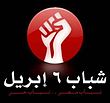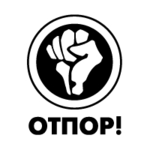När protesterna och dramatiken var som störst i Egypten började jag söka svaret till det hastigt uppkomna upproret mot regimen. Till min glädje fann jag en intressant vetenskaplig artikel om den arabiska bloggosfären. På många sätt var ju Egypten det land som många pekat ut som ett land där regimskiftet stod för dörren. Samtidigt som Mubarak verkade sitta hur tryggt som helst. En grundläggande faktor i motståndet var organiseringen på nätet via sociala medier. Al-Jazeera sände för några dagar sedan ett längre reportage med Ahmed Maher den drivande personen bakom 6 april-nätverket, som bildades 2008. Deras sätt att använda nätet för att åstadkomma fredliga protester mot regimen har hämtat inspiration från serbiska studentorganisationen Otpor. Otpor var en av de viktigaste aktörerna att mobilisera ungdomar mot Milosevicregimen. På bara några få år lyckades man håna, häckla och sprida en kult kring sig som gjorde Milosevic skitskraj. Otpors metoder influerade sedan Georgien och Ukraina i deras protester i mitten på 2000-talet. I programmet berättades att 6 April-ungdomsrörelsen har träffat flera av Otporaktörerna och man har till och med använt sig av en snarlik logga. 6 April-rörelsen hade redan 2009 en Facebookgrupp på 70 000 personer och har varit en av de mest aktiva organisatörerna till protester, strejker och demonstrationer de senaste åren.
Rasmus Fleischer har tidigare bloggat om allmän upprorsanalys (inspirerad av BBC:s Paul Masons lista å faktorer) och några bakgrundsfaktorer till varför det blev en revolt i Egypten. En av nycklarna till att förstå varför Egyptens unga generation gjorde revolt och satte dagordningen från den 25 januari ligger i den kraftiga aktiviteten på nätet och i bloggosfären. I en studie från 2010 på Harvard University av Etling, Kelly, Faris och Palfrey ”Mapping the Arabic blogosphere: politics and dissent online (New Media & Society) undersökte man den arabiska bloggosfären under 2009. Då framkom flera intressanta slutsatser. Egypten stod för den mest livaktiga bloggosfären och hade cirka 33 % av hela den arabiska bloggosfären var egyptiska bloggare. De var nästan lika många kvinnor som bland de egyptiska bloggarna och många hade dessutom en regimkritisk politisk agenda, till skillnad mot tex. saudiska bloggar som mer handlade om mode. Jag har saxat de viktigaste ur studien som tecknar den arabiska bloggosfären under 2009. Därefter har ju Facebook och Twitter ytterligare expanderat och varit en pådrivare vid sidan av bloggarna. Här följer lite saxade delar från de mest intressanta avnitten av studien. Kolla även in referenserna i slutet där hittar du intressanta länkar, artiklar och böcker:
EGYPT:
Marc Lynch (2007a) argues that Egypt has some of the most active political bloggers in the Arab public sphere, that is, bloggers who are actively engaged in political movements, instead of merely discussing politics.3 Our findings support Lynch’s argument. Egypt is the one national grouping where we see evidence of the kind of large-scale political clustering found in the United States and other politically active blogospheres, such as Iran’s. Egyptian bloggers comprise the largest structural cluster in the Arabic blogosphere, including nearly one-third of the blogs in our map. This is in part because Egypt has a large online population, as well as the largest population of any Arab country. The largest national cluster in the Arabic blogosphere is also one of the most politically active, and contains within in it several distinct sub-clusters, some of which correspond roughly to different parts of Egypt’s political spectrum, and which are critical of Egyptian President Hosni Mubarak and his government. Offline political speech and organizing is highly regulated in Egypt, and yet numerous strands of movement politics are evident and active in blogs. These subgroups include:
The Secular Reformist sub-cluster, which features political bloggers whose perspectives are typically secular, including socialist and Marxist viewpoints.4 A number of these bloggers are affiliated with the loose-knit Kefaya (‘Enough’) political movement, which is opposed to the president and his plan to install his son as future president of Egypt. Along with the 2005 presidential elections in Egypt, Kefaya is widely credited for propelling Egyptian bloggers from obscurity into the limelight of a new Arab public sphere (Isherwood, 2008).
The Wider Opposition sub-cluster, which is similar to Secular Reformist in most respects, also including Kefaya members, but contains more bloggers discussing the human rights and electoral reform-oriented ‘Tomorrow’ party, and appears to have more pan-Arabist bloggers. It also includes some bloggers from other countries writing in Arabic on similar themes and linking to the same kinds of online resources. Other bloggers address AIDS awareness and gay rights.
Almost half of the bloggers in the Egyptian Youth sub-cluster are women, one of the highest percentages of female bloggers in any cluster of the Arabic blogosphere.5 Nearly half of its bloggers fall in the 18- to 24-year-old range. Key topics in this cluster include single life, poetry, literature, and art, as well as human rights and women’s issues. While not as politically focused as other groups in the Egyptian blogosphere, the equal participation of women is an encouraging signal of the networked public sphere’s normative promise in male-dominated societies.
The Egyptian Islamic sub-cluster is focused primarily on discussion of Islam. These bloggers write frequently about their personal religious thoughts, how Islam fits into their daily lives, how to be better Muslims, and the Qur’an and Islamic interpretation.
The Muslim Brotherhood, whose bloggers form a distinct Egyptian sub-cluster, has an online presence that is remarkable for an outlawed organization (Ajemian, 2008; Lynch, 2007b).6 Despite the fact that they risk arrest, individuals in this cluster are still more likely to blog using their real name, rather than anonymously or under an obvious pseudonym. The Muslim Brotherhood cluster also features one of the highest levels of discussion of human rights (41%). Additionally, 70 percent of this group is male, one of the highest gender imbalances on the map.
Syria
Bloggers in this group are located almost exclusively in Syria and write primarily about domestic issues, including politics. This cluster features frequent, though typically mild, criticism of domestic leaders. Syrians are among the least likely in our study to express support for domestic political leaders. Out of over 3000 blogs we coded, fewer than one percent were found to express explicit support for terrorism (Figure 3).9 Further, 19 percent of bloggers are explicitly critical of terrorism. Only one percent show support for political Islam while nine percent criticize it. These results, combined with our findings using automated techniques, seem to indicate that concerns of policymakers in the United States regarding the use of the internet for spreading hate and supporting violent extremism may be overblown, although more specific research targeted exclusively at the question of extremism in Arabic blogs is required. 10
Table 1.
Rank # Blogs URL Type
1 2070 http://www.youtube.com Web 2.0
2 932 http://en.wikipedia.org Web 2.0
3 817 http://aljazeera.net Broadcast
4 816 http://news.bbc.co.uk Broadcast
5 795 http://www.flickr.com Web 2.0
6 667 http://ar.wikipedia.org Web 2.0
7 566 http://alarabiya.net Broadcast
8 500 http://www.islamonline.net Webnative
9 483 http://www.digg.com Web 2.0
10 456 http://www.manalaa.net Blog
Bloggers in the Arab world focus attention on their own local and national politics. When discussing their leaders, they devote more energy to criticism than support, a critical point of departure from the mainstream press. In some places (like Kuwait) bloggers are engaged in electoral politics, in others (like Egypt) they play key roles in movement politics, and in yet others (like Syria) they gently test limits of acceptable criticism within systems where open opposition is rarely tolerated. The presence of numerous female bloggers in societies such as Saudi Arabia and Egypt points to a more inclusive public dialogue than was possible before the emergence of this medium and practice. Our findings indicate that in part of the Arabic blogosphere (Egypt, Kuwait, Syria and the Levant/English Bridge section) there is an emerging networked public sphere operating at least in part on Benkler’s terms. It is a political discourse space apparently free of government control. It draws as heavily on peer-produced Web 2.0 resources such as YouTube and Wikipedia as on traditional mainstream media; however, it remains deeply enmeshed in the domestic, pan-Arab, and international news media ecologies.
About the author
Bruce Etling is the Director of the Internet & Democracy Project at Harvard University’s Berkman Center for Internet & Society. John Kelly is an Affiliate at Harvard’s Berkman Center and Chief Scientist at Morningside Analytics. Robert Faris is the Research Director at Harvard’s Berkman Center. John Palfrey is the Henry N Ess III Professor of Law at Harvard Law School and Faculty- Co-Director of Harvard’s Berkman Center.
References
Abdulla RA (2007) The Internet in the Arab World: Egypt and Beyond. New York, NY: Peter Lang. Utdrag ur boken: http://firstmonday.org/htbin/cgiwrap/bin/ojs/index.php/fm/article/view/1028/949
Ajemian P (2008) The Islamist opposition online in Egypt and Jordan. Arab Media & Society 4. http://www.arabmediasociety.com/?article=577
Isherwood T (2008) A new direction or more of the same? Political blogging in Egypt.
Arab Media & Society 6. Available at: http://www.arabmediasociety.com/?article=693
Kalathil S and Boas T (2003) Open Networks, Closed Regimes: The Impact of the Internet on Authoritarian Rule. Washington, DC: Carnegie Endowment for International Peace.
Lynch M (2007a) Blogging the New Arab Public. Arab Media & Society 1. Available at: http://www.arabmediasociety.com/?article=10

